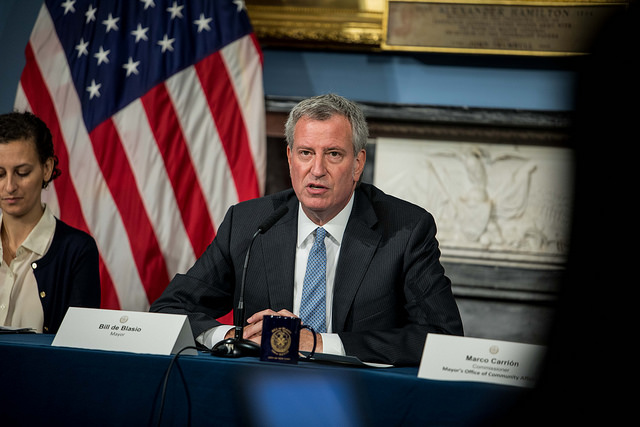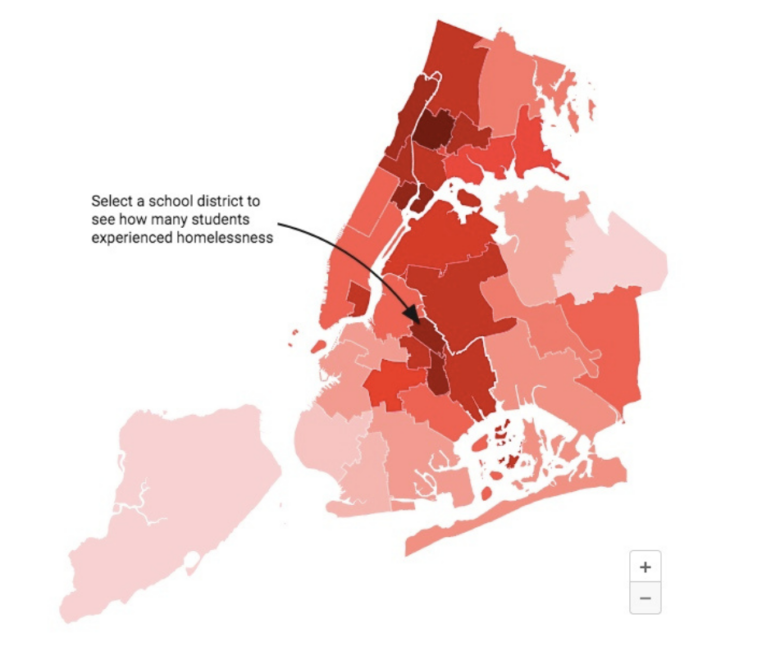
On Tuesday, Mayor de Blasio announced that the city was on track to hit his 10-year goal of preserving or building 200,000 units of affordable housing two years earlier than expected. Because of that success, the mayor is increasing the goal to 300,000 units.
Many details of that expansion will be revealed in coming days (on Thursday, for instance, the mayor announced a plan to invest in Mitchell-Lama preservation) but here’s what we know so far:
How is the timeline changing?
The plan will now run to 2026 instead of 2024. That means it will end just about four years after de Blasio—if he is reelected on November 7 and serves out his term—leaves office on December 31, 2021. Neither the extension nor the handoff to a predecessor are unusual. Mayor Bloomberg added an extra year to his New Housing Marketplace plan and Mayors Dinkins and Giuliani carried on the build-out of Mayor Koch’s Ten-Year Plan.
How does this goal compare to other mayors’?
It is bigger. Koch’s Ten-Year Plan was for 250,000 units and Bloomberg’s New Housing Marketplace plan was for 165,000.
Why is the mayor doing this?
First, there are the policy reasons: De Blasio says he was convinced to make the change after his housing team demonstrated a consistent ability to start more than the 20,000-units-a-year goal he’d set. At Tuesday’s announcement, Deputy Mayor Alicia Glen indicated that changes to the 421-a tax exemption and the way the mandatory inclusionary housing program was shaping up made the bigger goal realistic. Politically, de Blasio’s housing plan has been his biggest initiative and his largest point of friction with erstwhile allies in the advocacy world, and this larger plan could give the mayor the ability to address some of their concerns.
What has been built so far?
As of July, the city had started 77,651 units under Housing New York.
Is this the first big change to the plan?
No. Earlier this year the mayor added $1.9 billion in city funding to pay for boosting the share of units under the plan set aside for low-income households, with an emphasis on seniors and veterans. For the record, Bloomberg revised his plan too, moving to emphasize preservation after the financial crisis struck, extending his plan’s length to 11 years and adding in significant new money.
What will this expansion cost?
City Hall says the total cost of the 12-year plan is now $13.5 billion. When unveiled in May 2014, the 10-year initial blueprint for Housing New York planned for $8.2 billion in city money. State, federal and especially private money also play important roles.
Will there be more construction or more preservation?
The original Housing New York Plan called for 60 percent of units (120,000) to be preservation—meaning existing apartments that are refinanced or renovated to maintain affordability—and 40 percent (80,000) to be new construction. Those ratios will apply to the expansion. So the new target is 180,000 preservation, 120,000 new construction.
Will different income groups be served?
De Blasio on Tuesday indicated that the revised income breakdown announced earlier this year would still apply. That means 25 percent of the units created or preserved under the plan will go to families with very low or extremely low income, 19.5 percent will be set aside for moderate- and middle-income households and 55 percent for low income households. (Details on income levels are here.)
Will nonprofits play a larger role?
Some nonprofit affordable-housing developers have taken umbrage at the role they’ve played in de Blasio’s housing buildout, which has been dominated by for-profit firms. De Blasio addressed the sector in his remarks in Tuesday: “[T]he nonprofits, they know what they’re doing. Their intentions are the right ones. They know the community. They only lack one thing – money. So, we are giving a new impetus to the efforts of our nonprofits.” One element of that impetus is a program the mayor announced on Tuesday, “Neighborhood Pillars,” which will spend $275 million to help non-profits and “other mission-driven organizations” buy older rent-regulated buildings in “fast-changing neighborhoods where aggressive speculators” threaten existing affordable housing. This program will target 1,000 homes a year and 7,500 over the life of the plan.
But while nonprofits will certainly get more business because of the larger plan, it’s not clear they’ll play a proportionately larger role. Deputy Mayor Glen told reporters on Tuesday: “A third of our overall production or preservation to-date has been with nonprofit partners, and we expect that to continue and perhaps even grow a little bit more.”
What role will rezonings play?
A key part of the mayor’s housing plan to date has been a group of neighborhood rezonings where the city hoped to create new residential density that would include large numbers of affordable apartments. Rezonings of East New York and Far Rockaway have passed, a proposal for East Harlem is nearing a vote and at least eight other neighborhoods are in various stages of study or formal consideration. Some of these rezonings have been controversial because residents worry that new development will raise rents and drive out low-income tenants.
As he announced the expansion of Housing New York on Tuesday, the mayor was asked whether the new and larger target number meant that he expected a certain number of the current possible rezonings to go through, and if he’d be calling for others. The mayor suggested that no individual rezoning was indispensable to the overall plan:
We know there will be a number of re-zonings. … I think most of those are going to go through effectively. I’m never going to be shocked if a few don’t. Any place where we think something’s not going to work out, we’re going to take those resources, take that time and energy, move it onto the next one because there’s a lot of communities around the City that would like to see rezoning that understand it comes with a huge amount of investment in terms of community needs, that recognize that we can achieve multiple goals in a rezoning. We’re not going to lack for places to go. … I’m saying, if one’s not working you just switch up and move to the next – it’s kind of a rolling thunder kind of situation because there’s so much potential to create affordable housing through rezonings.
Glen added: “[O]ur production to-date has far surpassed our original projections and none of those units are attributable to the rezoning that we’ve already completed, so I think we feel extremely optimistic.”
Will this move satisfy critics of the housing plan?
Many housing organizations, including some whose principals have been critical of the mayor’s plans, were quoted praising the expansion in a City Hall press release. But others seem to be reserving judgement. The 300,000-unit goal itself will not convince many skeptics; they were generally leery of the 200,000-unit goal because they thought it put a premium on unit production rather than making sure the right kind of housing was built for the families who needed it most. The mayor’s move earlier this year to orient the plan more toward lower-income households was seen as a step in the right direction, but just one step. Since the expanded plan doesn’t alter those income targets, concerns about income levels—whether the housing is targeted at the deepest needs, whether the mayor’s affordable housing might gentrify neighborhoods with very low incomes—will persist.
It is possible, however, that with 100,000 extra units the plan can address with sheer volume many of the flaws that critics see in the shape of the housing plan. But there likely will still be worries about the broader impact on communities of the market-rate development on which some of the new affordable-housing projections depend.









6 thoughts on “Breaking Down De Blasio’s Expanded Housing Plan”
Pingback: De Blasio donor’s shocking testimony: $100K bought me the mayor – Harry Sullivan
Pingback: Star Witness Says Contributions Bought Access to NYC Mayor – Harry Sullivan
Pingback: Breaking Down De Blasio’s Expanded Housing Plan – Harry Sullivan
The bankrupting of NYC has begun. $1,125,000,000/year to start. Income, sales and property taxes will all have to be raised to cover this. What if there is a recession?
My question is, is the Mayor spending as much time and money to preserve the existing regulated housing stock as he is building 80% luxury / 20% affordable housing? In my neighborhood, Inwood, we had many more units 30 years ago than we do now because landlords are allowed to gut renovate, create needless MCI’s, jack the rent up and degregulate, and that’s even if they are getting J-51 subsidies from the government. Landlords harrass people out of their apartments, and they buy people out. They won’t make repairs timely or they make shoddy ones. Building-wide MCI’s are passed through DHCR pro-forma without the agency checking to make sure that the work was done or that it cost as much as the landlord said it did, and then the tenants have to pay for it. Some can’t. Does the government have a handle on how many apartments have been lost to each one of these causes? My guess is they don’t have a clue and don’t care to know. I hope that City Limits will do its part to find out. It’s stupid to be building more units, while causing major environmental, infrastructure and displacement impacts while we are leaking so many stabilized units. This building of huge new luxury buildings while little is done to recover the lost regulated units has to stop.
Pingback: Bill De Blasio’s New Affordable Housing Plan… – LMG Realty Services